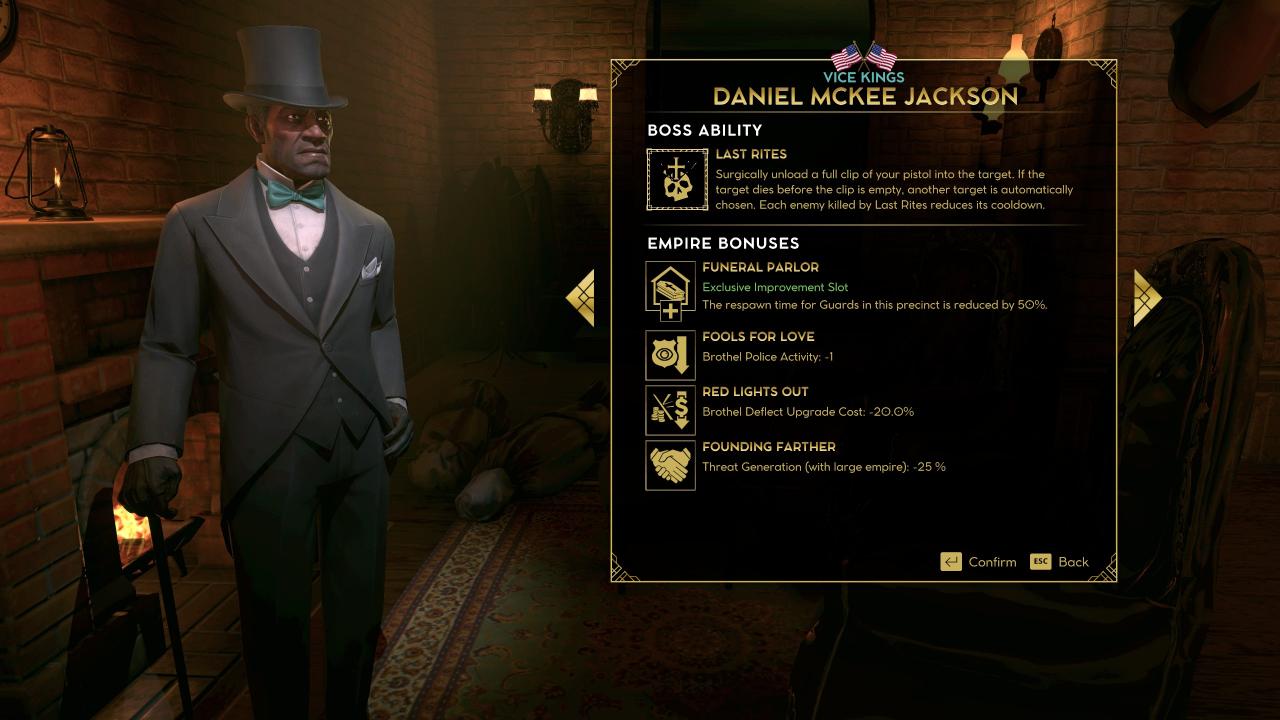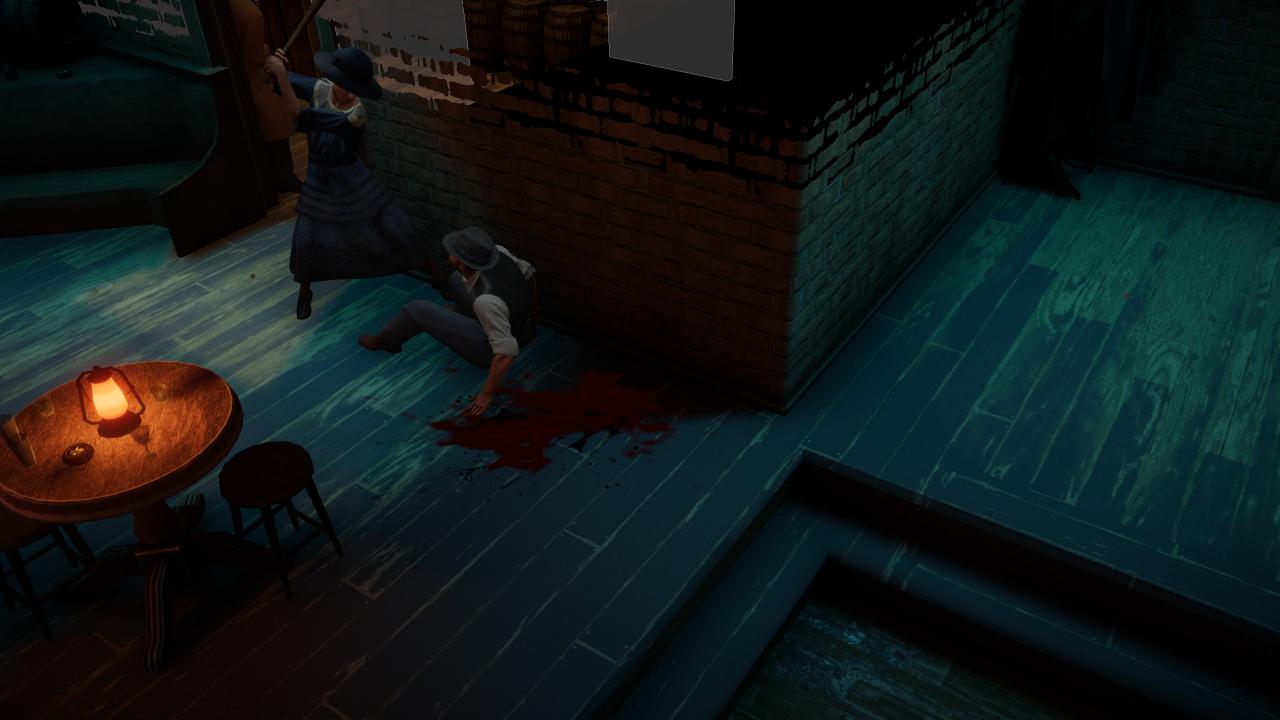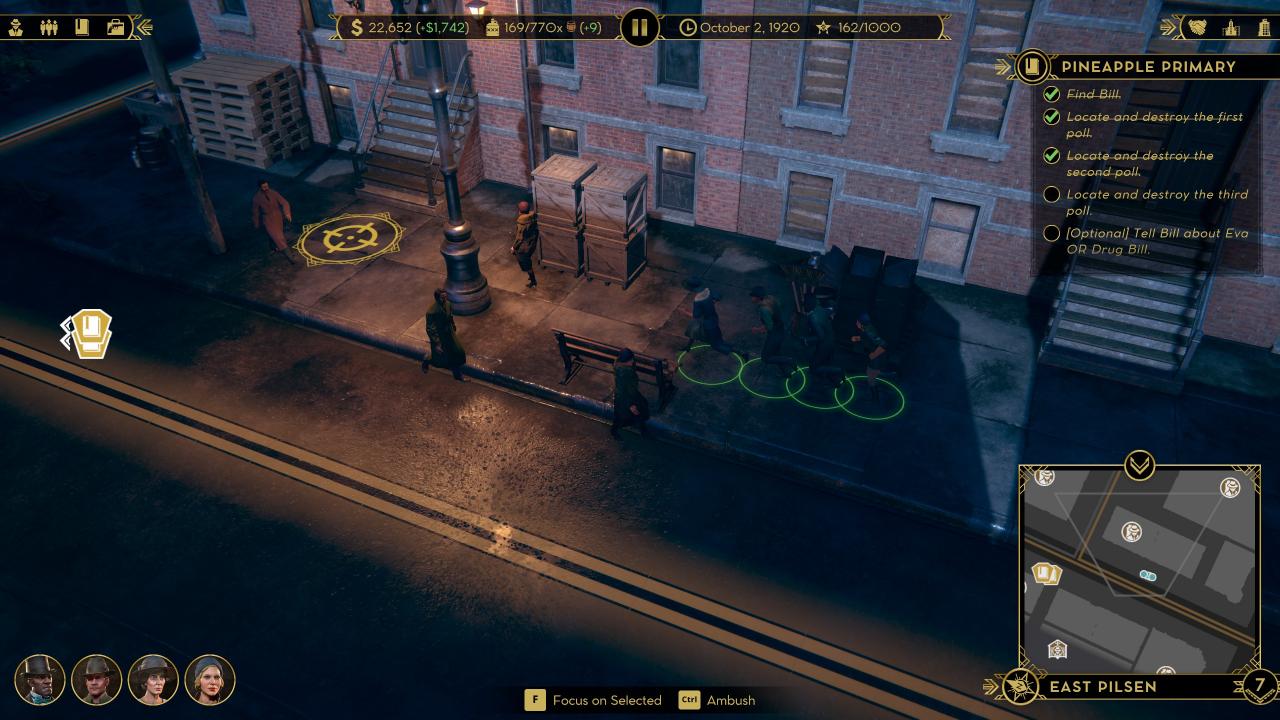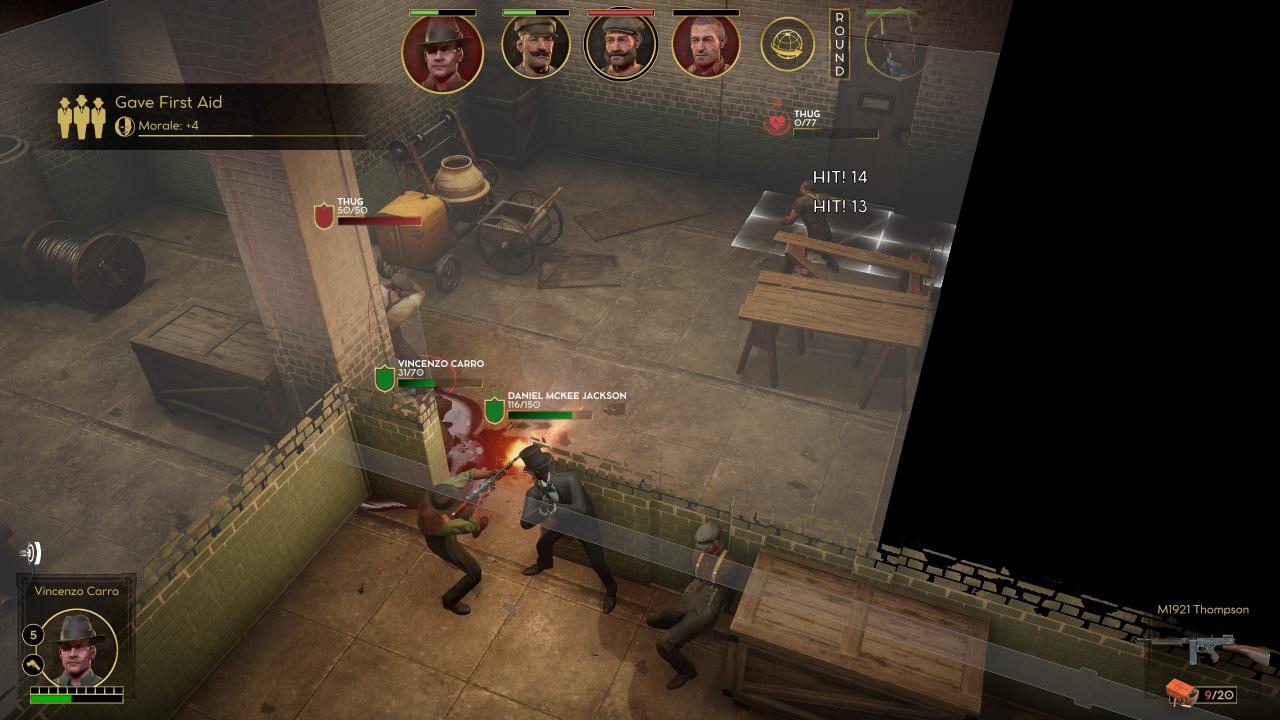Let me share a little story with you, since Halloween is fast approaching. Once upon a time a game designer named John Romero, who had not released a good videogame in Doom 2, suddenly awoke. Together with his wife they developed Romero Games, and collaborated with Paradox interactive, a strategy game darling. The result was a turn-based management-layer videogame set in 1920s Chicago. It was a great premise, and there was no doubt about the quality of its pedigree. Talent and passion were lacking. Empire of Sin, which was released on December 1, 2020 and is a huge disappointment, has a lot of bugs and is unfinished. It’s impossible to finish the game, even if you paid the full price. This was a problem that the Precinct Update (which is almost a full year old at the time this article was written) tried to fix, but failed. As with all Empire of Empire games, the tactical layer has some nice features, but it is lacking in nuance and complexity. Battles are essentially a matter of taking pot shots until someone dies. Special moves and actions are not very useful, since they are often worse than regular attacks and are only situational.
I’m saddened to see that this game seems abandoned. There has been no news in almost a full year. The forums are flooded with unanswered inquiries about the state of the game. And there is still Expansion Pack that’s waiting for release. Romero Games’ page claims that it is a “new dawn” for Romero Games. Our studio and our career were built on the first-person shooting genre. We’re 100% committed to it. The current project, an entirely new FPS, is a brand-new IP. However, there has been no announcement on whether or not they intend to complete what they began with Empire of Sin. Romero Games was contacted and I asked if the company planned to finish the game and release the DLC. They did not respond. If it happens, I will update this article.

It’s not a secret to those who read my reviews that I do not enjoy writing bad reviews. Instead, if i don’t care for a particular game I will ignore it, and go on to another one. As I always say: “life’s too short to waste your time with games you dislike”. What’s the point of reviewing games that you don’t like? Most reviews are confirmation bias, right? Why are you telling this to me? There’s a big difference between me not liking a video game enough to continue playing it and it being broken. Sometimes a new concept will grab your attention and make you want to invest. When the reviews of Empire of Sin first appeared, I thought they were a group of spoilt reviewers who had their taste in digital media influenced by more refined games of this genre. What could possibly go wrong? If it really was bad, wait for a few months. It will be fixed – like all Paradox games these days – until it becomes a fun title. This is a warning to temper your expectations. Empire of Sin is a game I enjoy, but I do not dislike it. In fact, the more I played it, the more I liked it. It has charm and simplicity and you can play it while listening to music or podcasts, or if you just want to relax after a hard day of work.

Setting
What is this Empire of Sin? This is a strategy-based game similar to Enemy Unknown set in 1920s Chicago during Prohibition. The game puts you in control of a young, ambitious criminal who is destined to become a big shot. The gameplay is split into two dimensions, similar to the inspiration. You can rule an empire of sin by making strategic decisions to advance your agenda. The real-time layer is available with the option to pause it when necessary. There’s no fast-forwarding option, and I could not find one. So, prepare yourself to stare at the screen when nothing is happening.
It’s a cool game, with a great art style. Even though I prefer a realistic feel, the over-the-top features on the characters capture their personality quite well. The choices are… strange, for sure, such as a group based off a circus. It’s not too far-fetched. It’s cartoonish appearance lends itself well to funny scenarios: imagine you hired a woman who is a gun-toting manic and also has a knack for executing goons using a World War 1 nail spiked bat. Like the image below. It’s charming, but in a weird and sinister way.
In-game characters are all cool, and they have distinct personalities. Vicenzo Carro (a Chicago Typewriter with scars and fedora) and an Asian woman who loves bombs were in my gang. Alphonse capone is the mobster of early 1920s who leads this gang of no-gooders. In Empire of Sin the characters have personality, which is consistent with the way they look and act.
These traits, however, are superficial: They may have some modifiers in their names and refuse to work alongside criminals that they don’t like, but they are otherwise no more than the average squad member. This is a missed opportunity to examine the relationships between characters. XCOM: Chimera Squad, for example, did this extremely well with its story, with friendly bantering between aliens working in the police force, and by exploring post-invasion interactions between aliens and humans, their former enemies turned friends. Darkest Dungeon II excels at this ludologically, since character interactions are at the core of its emerging narratives. Some become suspicious, while others engage in friendships and relationships that grant them bonus points during fights. Others grow resentful, refuse to assist, or even turn into cowards by refusing to fight, skipping turns and even stealing. It is this that encourages the players to foster these relationships among the members of their party to get the most out of them.
Empire of Sin is great at creating atmosphere. Just by looking at the screenshot of Chicago one can instantly identify the period. You can smell cigars and whisky in the dimly-lit rooms of the speakeasies. It’s also a little foreboding. The player is able to enter every city building, which has an interactive aspect. This is nice even though there are usually not many things to do in the buildings, except to talk to people. This brings me to my next point: the management side of the game.
The Management
The word “lackluster”, how many times have you heard it? Unfortunately, the 3D map isn’t very interesting. Around 60-70 percent of the gameplay takes place in the overworld, because that’s where all the moves are made. This is also where mob bosses sit down and have their meetings. This map has three different layers, including the 3D or Street View, which zooms in the most. This view gives you an overview of the precincts around your own and those surrounding it. The city view is self-explanatory. You’ll scroll between the city and neighborhood views most of the time. This is because it’s the best way to play. It’s not a criticism, but I do appreciate how easy it is to access all of the available information and the simplicity with which everything is presented. It would be nice to have more reason to interact with 3D maps. Aside from 3D battles that take place in 3D but are outside of the city map, there is little to no reason to do so.
Empire of Sin doesn’t have the best management system, but neither is it the most interesting. While other games may be excused for doing this, XCOM’s main focus was on tactical battles. The strategic layer served as a context of what is happening. It wasn’t till XCOM 2, that the strategic part got the attention it deserved. The Gears Tactics game is arguably worse as there’s nothing to do but choose between side missions and equipment. Gears, on the other hand, is a more narrative experience. Empire of Sin however is more of an open-ended sandbox. If you want to manage a criminal underworld, city of gangsters would be a better option.
This is the place where management takes place. The city map has been divided into different sections, each of which is then subdivided into precincts. The precincts have a limited number of slots where criminal activities can be set up. The problem arises, however, when there are only four building types: brothels (breweries), casinos and speakeasies. As long as you keep the money rolling in from the barrels, your breweries will continue to produce alcohol, which is necessary for the other buildings to operate. The buildings are upgradeable, but they’re mostly just stat upgrades. You don’t need to worry about spreadsheets or complex brain moves. Do you have the cash? Open another bar and increase the whisky production. As long as the establishments are open to the general public, the production of alcohol is in balance, then there is no need to worry. The best way to survive on the edge would be to have more than you actually need, since they may incur losses occasionally. My current playthrough only has two precincts, two breweries within them, with the remaining bars and a single brothel bringing in around 1700$ per week. I was able to earn 95,000$ in my first year to outfit my crew, and plan how to conquer more powerful families. This aspect of the gameplay was clearly not given the same attention as the tactical battles, which shows. Diplomacy is also available, but it is useful only if you want to trade barrels with other families – which you’ll do if there are too many. There are few personal relationships and opinions between players in the game, which are important in Crusader Kings or City of Gangsters. The only exception is “like/dislike’ relations among gangsters that can be hired from the blackbook. What’s the point in avoiding the wars with other gangs, and depriving yourself of this best part of game to just see the numbers increase on the interface, when the turn-based combat is the most important part?
When the group moves around the map in 3D, it looks like they are the Scooby-Doo Gang. It’s very intimidating

Battles Tactical
It’s not acceptable that games of this type fail to deliver something… at least decent. It’s not that I expect all games to excel in every way (like XCOM Enemy Unknown), but it is hard to accept the failures of a title with such prestigious pedigree. Before the release of Empire of Sin the XCOM Reboot had been available for eight years. XCOM 2, for four years. Chimera Squad, for six months. Gears Tactics, for eight months. Valkyria Chronicles 4, for four years. Phoenix Point, for one year. Into The Breach, for almost five years. Omerta, City of Gangsters, for seven years. Divinity Original Sin 2, for three years. Battle Brothers, for three years. And so on. While it was easy to overlook the absence of meaningful mechanics in previous years, it is hard today. XCOM did not just reboot, but resuscitate an entire genre, launching it into a golden age. By streamlining the classic’s mechanics and capturing a whole new audience, including myself, who wasn’t even born when the first installment of this series was released in 1994. XCOM 2, on the other hand, focused more on the number of actions that your units can perform and how they work together. Gears Tactics introduced a momentum system that rewards soldiers for executing missions. Phoenix Point’s signature system of free-aim placed more focus on positioning. The turn-based gameplay in Into the Break showed that a system could be as complicated in an 8×8 grid as in the massive 3D battles of the previous titles. To round off the list, Divinity Original Sin 2 shows how you can use your character abilities to trigger environmental and status effects. How can Empire of Sin’s poor implementation and design be excused when there is so much inspiration to use?
The battles are played out as you would expect, except that instead of having your team move all at once, and then moving the enemies, this system relies on initiative statistics, which is more like the classic JRPGs such as Darkest Dungeon. In each turn, the unit with the greatest initiative stat gets to go first, followed by the next highest and then so on. It is likely that the units you control will be the first to attack the enemy. This might not hold true later, however, as the questline was broken during my initial playthrough and I needed to start a fresh save. This initiative system in Empire of Sin adds little to the game, unlike other games like Darkest Dungeon 2 where each move can be a life or death decision for the player. It also makes it difficult to plan because you cannot preview stats of the enemy. The units in DD2 can “act faster” by activating certain moves. This trade-off is sacrificing a movement this turn to allow them to move faster the next time. In a high-stakes game like Darkest Dungeon 2 every combo that is completed is a great feeling. But, if it is not, you feel a sense impending disaster and a wasted opportunity. The game’s basic premise isn’t great, but there are many positives.
Let’s begin with the most annoying problem: When a fight starts, all of your units spread across the map. Occasionally, rather than running to the nearest cover, some will run straight towards the enemy, standing in the open. It’s annoying, but it’s made even worse by the fact that, because you are relying solely on initiative statistics to determine the initial move, the enemy may be able to severely hurt or kill one of your goons, before you have a chance of placing them behind cover. I’ve often had to restart missions due to this. It’s especially bad because Empire of Sin injuries can last months. Remember that there is no fast-forwarding, so even if someone has been injured for 63 consecutive days (! ), you won’t be able to do anything about it. They’ll have to be off the job for over two months if they get injured. Imagine you’re starting a game and hiring two bootleggers. One of them gets injured and shot in the very first mission. You’ll have a handicap for the first month-and-ahalf, and be unable to accomplish anything, except to try to get your acting goon hurt by clearing squatters from derelict building. Even worse, you’ll be staring at the map for 30 minutes while waiting for your squatters to recover. You may also be prevented from completing timed missions, as you risk losing the entire game. What do you do now? What do you decide to do? It can even be worse if your investments were made too early and you have no financial way of recovering. While crew management and injuries appear in all titles, it’s important to note that there is a difference between mechanics being enjoyable and making you make tough decisions and just stopping you from playing. This is a disaster waiting to happen. I’m shocked that it passed quality control and no one noticed.
You can have more natural battles: for example, you could enter the bar of a faction with which you are not yet at war. You can trigger an ambush if you place gangsters before firing. Is there anything more gangster-like than surprise rival families at a time when they are least expecting it? As you would expect, it only happens one time. Once families have declared war on each other, they are ready to be peppered whenever someone suspicious passes by.
The good news is that you can equip each unit differently, depending on the current situation. You need to destroy a large building, but you only have two or three crew members available. Equip all crew members with grenades. Are you taking too many hits? Buy some silk vests. Want more power at close range? The answer is shotguns. It is clear that the inventory system was well thought out. I am happy with it. Each weapon has its own stats, and each is unique. The usual gangster weapons are here, and they don’t hesitate to show up: The 50-round Thompson with vertical foregrip. The BAR 1918. The Colt. The Remington Model 10 Shotgun. The party also features some more unusual options: the Gewehr Nagant and Mosin 98 are both interesting selections, and an improvised Zip Gun can be used by those who want to get the job done but lack the money for a good shot-barreled shotgun or single action revolver.
If you’re not afraid to get your hands dirty, there are cheaper and more crude options available: sledgehammers and bowie knives. You can also find lead pipes, baseballs bats, brass-knuckles and axes. Each gun comes with realistic clip sizes. This has an impact on gameplay that I really appreciate. Vincenzo Carro (known as “Lucky” in the street) will have to be more careful with how much ammunition he spends if he uses his 20-round Thompson. Why would you choose one over the other? As with everything in life, it is always more expensive to buy the best. Prices, blast radius and damage of grenades are different. Empire of Sin’s arsenal is more versatile than any other game I have played. Someone on the development team has thought through the options. There are a variety of health items, from medical kits and bandages that remind me of World War 1 supplies, to the more esoteric health tonics which are essentially Diablo’s health potion. All of them have different stats and bonuses. They also cost varying amounts. I think it’s nice to have a wide range of options. There are also different trinkets and ammunition. The first increases the weapon’s stats (or adds modifiers like the Riot Rounds which have a chance of knocking enemies back by 25%).
The recoil of the weapons does not always match the shooting animation, and when enemies die, their death animations do not correspond to the damage they have taken. Some people will jump into the air after being shot by a pistol, while others just shut down and fall on the ground. The recoil from the guns doesn’t always match up to the firing animation, and the animations of enemies who die don’t correspond with their damage. Some explode in the air when shot, while others fall down after taking an incredibly large slug, or simply shut off and collapse after taking massive blows.
The last thing I dislike about the combat system in most buildings is there’s not much incentive to change your unit positions to gain an advantage over your enemy. Take potshots as long as you are safely behind the brick wall. It is not a good idea to move out without shooting, as the majority of times the enemies will be larger than you. This can cause the game flow to become stale if it is done incorrectly. It’s much more challenging to face lesser but competent opponents than huddling around a wooden box and praying that your shots will kill them first. It might be different later, but it’s unlikely. So, things are going to get a bit formulaic. Start the mission, thin out the herd while in a secure position and then move on to end the misery of the last few guys.
So far, during my time playing, I have not seen a single mission that involved a drive by. We are what kind of gangsters we truly are if we use taxis or walk everywhere? Last question, why do we have to heal each character manually after every encounter? If you can’t heal the characters afterward, that’s fine, but having a medic in your team is a much better option.

Mission System and Bosses
The number and frequency of missions in the game was a pleasant surprise. It’s hard to say, but I think that each character has a specific mission. Other missions are constantly presented, though they don’t appear randomly. They seem to be curated by hand. The missions are varied, ranging from blackmail to killing high-ranking members of your family to removing religious nuts near the brothels. Each mission has multiple outcomes. Characters can be intimidated, killed or bribed to achieve your goal. This doesn’t really have long-lasting effects, and it has no consequences at all. But it can be a fun touch.
As Daniel McKee Jackson I am currently playing my friend Bill’s campaign to be mayor of Chicago. During this questline his secretary attempted to convince me to stop helping him. It was my choice whether to inform him or turn him against me. As the cold-blooded gangster I am, I have run Bill’s errands. I also convinced his political rivals that they would be better off dropping out of the race for office. Did you know that many people are killed every year while jogging. Some people are even run over twice by trucks. We don’t really want this to happen. It was now time for some tough negotiations to convince voters that voting for Bill was better than choosing other less morally questionable options. Jackson finally decided to shoot an entire clip at Bill’s secretary, because he knew that Bill would be able to get six bullets through the chest if snitches were found.
The bosses are the final part of this review. Each boss has its own unique boss skill (a technique to be used during tactical battles), and an empire-wide bonus. That’s it. Have I mentioned that most things in this game are lacking?
The Bad is Good
Empire of Sin doesn’t have a great deal of polish, but it is still a good game. Bad animations or small things? Even XCOM’s camerawork was abysmal. Phoenix Point, unlike Gears Tactics, lacks personality in its units. The Planet Coaster is not the management side of things, however Gears was only able to manage what to do. The linear nature of the problems will quickly become an unmanageable mess.
Do I think you should purchase it? It’s a difficult question. What if Romero Games fixed the bugs and issues highlighted in this review. Yes, of course! There’s probably a decent game hidden somewhere, but the ideas in this are all half-baked and never delivered to its premises. Empire of Sin is one of those bad games that are so fun and entertaining to play. You could certainly do worse if you buy it cheaply or on sale from an online retailer. There aren’t many options when it comes gangster games. If you’re desperate for a gangster video game, your options are City of Gangsters or Empire of Sin. What you prefer depends entirely on your taste.
You should be aware that Capone is still a game-breaking boss. If you are planning to purchase Empire of Sin, you will want to avoid him until the bug is fixed.